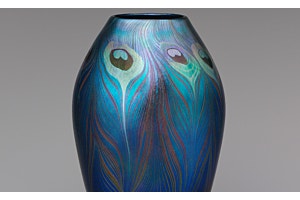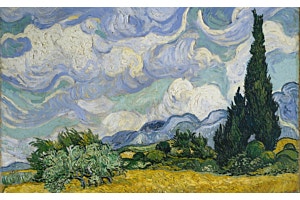
This season, we’re delighted to introduce an elegant shawl in honor of The Met’s Department of Textile Conservation, which is celebrating 50 years since its establishment in 1973.
Under the leadership of Janina Poskrobko, Conservator in Charge, this crucial department oversees the research, technical study, preservation, and conservation of approximately 36,000 textiles—from costumes to carpets and tapestries—across 12 of the Museum’s curatorial areas. Our new Met Florals Embroidered 50th Anniversary Shawl has been carefully and collaboratively designed to showcase the richness and diversity of the Museum’s many textiles.


The idea to present a custom shawl for the Department of Textile Conservation's 50th anniversary emerged from discussions between Poskrobko and Stephen Mannello, Head of Retail & General Merchandise Manager at The Met Store. Our design team worked closely with the conservators to choose sources of inspiration that represent as many Museum collection areas as possible. It was also important to settle on a cohesive visual theme, so after extensive discussion, nine textiles were chosen, each boasting a floral motif.


“Flowers are universal and beautifully depicted on textiles, whether woven, embroidered on silk with gold- or silver-gilt metal thread, or painted or dyed by hand or other techniques,” notes Antonia Capasso, associate administrator in the Textile Conservation department. “Each conservator submitted a concise selection of object images from the 12 curatorial departments that we work with. The final shawl includes motifs from nine objects belonging to six curatorial departments: Asian Art, Islamic Art, The American Wing, Medieval Art, European Sculpture and Decorative Arts, and The Robert Lehman Collection.”


Among the selections are two Japanese silk kimonos depicting lush cherry and plum blossoms, the most commonly depicted blooms in Japanese art.


Conservator Kristine Kamiya, liaison to the Museum's Department of Asian Art, Japanese and South & Southeast Asian collections, explains, “The cherry blossoms (sakura) depicted on a dark-pine-green kimono from the second half 18th century (shown above) represent a new beginning and revival. The plum blossoms (ume) seen in a Noh costume (1690–1799) (shown below)—used for a female role in the comedic interlude of the Noh (or Nō) theater known as Kyōgen—symbolize hope and perseverance, thought to ward off evil spirits.”


The deterioration of silk is a constant challenge, Kamiya says, and conservation on these pieces would be a long-term project. “This is the perfect opportunity to share these beautiful examples of Japanese textiles without having to handle them for display.”
Also informing the florals on our shawl is a woman’s robe made in the early 18th century during China’s Qing dynasty (1644–1911). This particular garment was displayed at The Met in 1978 and 1981, after which it underwent conservation. Once it was restored to a stable condition, it was exhibited again in 2008.


“Unlike the famous dragon robes from the Qing dynasty, many women’s robes were decorated with flowers, fruits, and other auspicious symbols,” conservator Minsun Hwang, liaison to the Department of Asian Art, Chinese and Korean collections, tells us. “It is interesting to see the peony-filled garden setting on this robe along with the unusual inclusion of two pairs of Chinese lions playing with beribboned balls in a peony-filled garden background at the lower edge of the garment. The peony symbolizes wealth and prosperity, and is favored in Chinese culture; therefore, clothing and home decor have depictions of peonies, including having the flowering plant in their gardens.”
Associate conservator Julia Carlson, liaison to the Islamic art department, spotlights two textiles selected for the shawl: an early 19th-century Turkish towel end and a northern Indian pashmina carpet (second half 18th century). The carpet, Carlson explains, has received two conservation treatment campaigns.


“In the 1990s, a lining not original to the piece was removed, an area of loss was consolidated through fabric, and Velcro was sewn to all sides for display," Carlson says. "In 2022–23, the carpet was remounted in a new gallery installation mount made of more archival materials. Previous treatments were left undisturbed as they are still providing support to the original.”
The carpet, featuring a millefleur motif that we've adapted on our shawl, has been on display in The Met’s Islamic art galleries, and was recently included in Prayer and Transcendence, an exhibition at The George Washington University Textile Museum.
“The towel-end fragment has been in The Met collection since 1879,” Carlson notes. “There are selvedges (a type of edge that prevents unraveling) present on both sides of the textile, which indicates the loom width of the fabric. Metal-wrapped thread is used for the silver embroidery.”


An 18th-century American embroidered coverlet made by Ruth Culver Coleman (died 1801) and a 19th-century chalice veil possibly made in France are among the other textiles represented in the shawl's decoration.


From a design perspective, it was imperative that each source object presented a pattern that was legible enough to faithfully recreate. Once the final selections were made, our designers created a digital collage that seamlessly united each pattern to suggest harmony between Museum departments. The finished design is a soft and sumptuous wool-and-silk shawl, hand embroidered by artisans in India. A macramé fringe adds an elegant finishing touch, as does our special hangtag acknowledging the Department of Textile Conservation’s important milestone.


Shop the Met Florals Embroidered 50th Anniversary Shawl in-store and online, alongside our fleet of new fall scarves.





